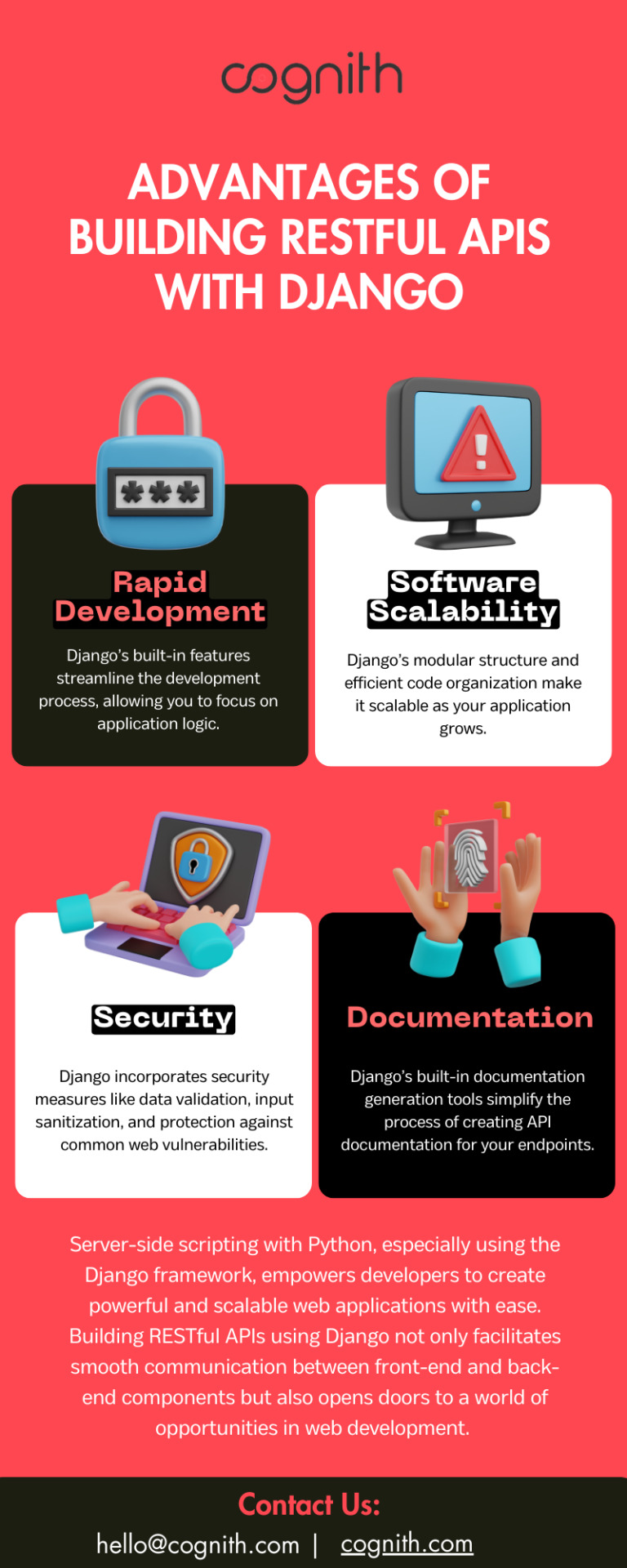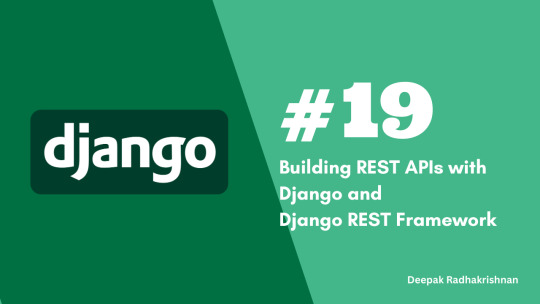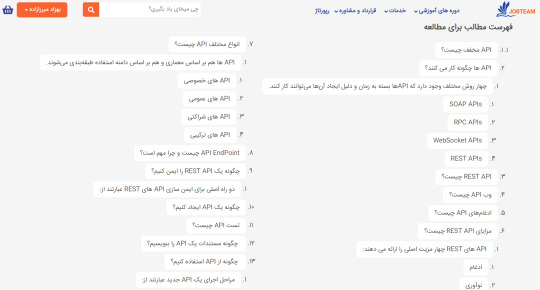#Django API
Explore tagged Tumblr posts
Text
Django and GraphQL Integration
Integrating Django with GraphQL for Efficient API Development
Introduction Integrating Django with GraphQL offers a powerful combination for building modern web applications. GraphQL, an open-source query language for APIs, provides a more efficient, powerful, and flexible alternative to REST. It allows clients to request exactly the data they need and nothing more, making it a perfect match for the Django web framework. In this article, we will explore…
#Django API#Django GraphQL integration#graphene-django#GraphQL API#modern web APIs#Python web development
0 notes
Text


It's been a real fun! I'm hoping to work on the front end next and make it available for everyone 😁!
#pixiesdiary#YouTube data API#python#Django#rapunzel#disney channel#channel searching#programming#work in progress#fun project
3 notes
·
View notes
Text
🌟 Ready to become a Full Stack Python Developer in 2025?
Join our FREE Master Class on Python & Full Stack Web Development led by expert Mr. Mahesh – perfect for beginners, students, and aspiring developers!
🧑💻 What You'll Learn: → Python Programming → Django Framework → REST APIs → HTML, CSS, JS, Bootstrap → Angular → Database Integration
📅 Date: 9th April 2025 ⏰ Time: 7:30 AM IST 📍 Mode: Online & Classroom (KPHB, Hyderabad)
💥 Real-Time Projects | Career-Ready Skills | Certification Guidance
📌 FREE Demo Registration 👉 https://tr.ee/2YzYUA 🔗 All Upcoming Batches 👉 https://linktr.ee/NIT_Training 📞 Contact: +91 9642 76 9999

#Python#FullStack#WebDevelopment#LearnToCode#FreeMasterClass#NareshTechnologies#Django#API#JavaScript#Angular#DeveloperJourney#CodingLife#OnlineClasses#KPHBTraining
0 notes
Text
Integrating Time Tracking Software with Other Tools for Seamless Workflow Management
#TimeTracking#WorkflowManagement#Productivity#SoftwareIntegration#Automation#ProjectManagement#Django#APIs#BusinessTools#TeamCollaboration#SeamlessWorkflow#WorkEfficiency#TechIntegration#TaskManagement#RemoteWork#EmployeeMonitoring
1 note
·
View note
Text

As a freelance Python developer, I create powerful web applications, APIs, and automation scripts. With expertise in frameworks like Django and Flask, I deliver secure, scalable, and efficient solutions tailored to your business needs. Let's collaborate and turn your ideas into reality with clean, reliable code.
#python developers#django#api development#framework#web application#website design#freelance python developer#flask
0 notes
Text
Top Tools for Web Development in 2025
Web development is an ever-evolving field, requiring developers to stay updated with the latest tools, frameworks, and software. These tools not only enhance productivity but also simplify complex development processes. Whether you’re building a small business website or a complex web application, having the right tools in your toolkit can make all the difference. Here’s a rundown of the top…

View On WordPress
#Angular Framework#API Development Tools#Back-End Development Tools#Best Tools for Web Development 2024#Bootstrap for Responsive Design#Django Python Framework#Docker for Deployment#Front-End Development Tools#GitHub for Developers#Laravel PHP Framework#Modern Web Development Tools#Node.js Back-End Framework#Popular Web Development Software#React Development#Tailwind CSS#Testing and Debugging Tools#Vue.js for Web Development#Web Development Frameworks
0 notes
Text
Unlocking the Skills of a Full Stack Developer
To excel as a full stack developer, embark on a journey that begins with mastering the foundational technologies of web development: HTML, CSS, and JavaScript. These essential skills will empower you to build and style dynamic web pages. Next, immerse yourself in front-end frameworks such as React, Angular, or Vue, which will enable you to create engaging and interactive user experiences.
On the back end, dive into server-side languages like Node.js, Python (utilizing powerful frameworks like Django or Flask), Ruby on Rails, and PHP. Understanding how to leverage databases is equally vital, so familiarize yourself with both SQL (using systems like PostgreSQL and MySQL) and NoSQL options like MongoDB.
A strong grasp of APIs is crucial for modern development, so learn how to create and utilize RESTful services and explore GraphQL for efficient data retrieval. Equip yourself with Git for version control, allowing you to track changes and collaborate seamlessly with others.
Enhance your problem-solving abilities through coding challenges on platforms like LeetCode, and build an impressive portfolio by undertaking personal projects or contributing to open-source initiatives. Embrace a mindset of continuous learning by following industry blogs, enrolling in online courses, and participating in workshops to stay ahead of the curve. There is also a masterclass to help you understand these concepts better.
Don’t overlook the importance of soft skills; effective communication and teamwork are vital in today’s collaborative work environment. Finally, seek out mentorship to guide your development and engage in code reviews to benefit from the insights of experienced developers. By diligently following these steps, you can cultivate the expertise and confidence necessary to thrive as a full stack developer in a competitive landscape.
#FullStackDevelopment#WebDevelopment#HTML#CSS#JavaScript#React#Angular#Vue#NodeJS#Python#Django#Flask#RubyOnRails#PHP#SQL#NoSQL#MongoDB#APIs#RESTfulServices#GraphQL#Git#CodingChallenges#LeetCode#PortfolioBuilding#OpenSource#ContinuousLearning#TechMasterclass#SoftSkills#Communication#Teamwork
1 note
·
View note
Text
Nuevo Curso Aprende Multi Tenant con Django y Docker
🚨#Aprende y Domina el Desarrollo #multitenant con #Django y #Docker | #Rebaja por Lanzamiento 🚀 USD 9.99 o menos
Multi Tenant es una arquitectura que permite a una sola aplicación web servir a múltiples clientes (o “inquilinos”) de manera aislada y segura. En el contexto de Django y Docker, esta configuración es crucial porque permite escalar aplicaciones de manera eficiente, manteniendo los datos de cada cliente separados y seguros. Esto no solo mejora la seguridad y la escalabilidad, sino que también optimiza el uso de recursos y simplifica el mantenimiento.
#django#python#postgresql#web#jquery#udemy#programming#api#signals#teaching#tenant#multi tenant#saas technology#docker
0 notes
Text

Server-Side Scripting Explained: Simplifying Web Development
Explore how server-side scripting works, from processing user requests to delivering customized content. Learn the benefits for both developers and users.
0 notes
Text
youtube
0 notes
Text
Building REST APIs with Django and Django REST Framework
Introduction RESTful APIs are essential for modern web applications, enabling seamless communication between the frontend and backend. Django REST Framework (DRF) is a powerful and flexible toolkit for building Web APIs in Django. In this guide, we’ll cover the basics of creating a REST API using Django and DRF, including setting up the project, creating models, serializers, and views, and…

View On WordPress
0 notes
Text




Yeah, I've finally made it! Though, with limited functionality, 'cause I use free accounts everywhere 😬! (I've been so stupid, I accidentally added my name to the domain 🙁)
#pixiesdiary#python#django#google data API#web development#web searching#programming#EasyTubing#rapunzel#Disney channel#testing#youtube
1 note
·
View note
Text
Full Stack Python Developer

Python has become one of the most popular programming language ever since the growth of Data Science, Machine Learning and Artificial Intelligence etc., over the years. In the web application development, python has a large number of modules, libraries, framework like Django, Flask etc to make web development easier. You need to follow a roadmap to become a Full Stack Python Developer.
Some major roles of Full Stack Developers are as follows:
Designing User Interface (UI)
Developing Backend Business Logic
Handling Server and Database connectivity and operations
Developing API to interact with external applications
Integrating third party widgets into your application
Unit Testing and Debugging
Testing and Hosting on Server
Collaborating with cross-functional teams to deliver innovative solutions that meet customer requirement and expectations.
To become a Full Stack Python Web Developer, you need to be proficient in HTML, CSS and Java Script, have a good knowledge of database management, good understanding of the libraries, framework like Django, Flask, CherryPy etc which will help in streamlining the process of writing web applications. Frameworks are collections of modules or packages that provide a default application structure facilitating quick and easy development of web applications. These frameworks ease the development of both the front-end (HTML, CSS, JavaScript, PyScript, Brython etc) , back-end (Django, Flask, CherryPy, Pyramid ) and Database Management tasks to design, manipulate, and decipher queries (MySql, MongoDB, SQLite), GIT etc for web application development.
if you wish to make a career in Data Science, you need to have a good understanding of mathematics and statistics, good understanding of the database concepts, understanding of various libraries and tools associated with Python, various Algorithms used for Machine Learning, Artificial Intelligence, NLP, Manipulating data, Data Analytics and Visualization etc. if you are performing tasks like Automation, Data Analytics, machine learning, robotics, chatbot with AI etc python does make your life easier.
Conclusion: Python is a versatile and in-demand programming language, and it is easier for anyone to pivot from one field to another easily. If you have a passion and dedication to learn new technologies and develop your skills and knowledge, you can become a full stack developer by joining our Edujournal Bootcamp, which will enable you to learn job-relevant skills. With opportunities in Data Science and Web Application Development growing by the day for Python Developers, do not miss this wonderful opportunity to make a great career out of it. You will get an opportunity to work with our experienced professionals along with their overwhelming support. Happy coding !
URL : www.edujournal.com
#user_interface#front_end#back_end#business_logic#api#web_development#Python#technology#skill#knowledge#Edujournal_Bootcamp#full_stack_developer#Django
0 notes
Text
به بیان دیگر، API مجموعهای از پروتکلها و ابزارهایی است که به نرمافزارهای مختلف مثل اپلیکیشن، سایت و دیگر نرم افزارها اجازه میدهد تا با یکدیگر ارتباط برقرار کنند.
نزدیک به 35 مورد از این مبحث را مطالعه و آشنا شوید
https://jobteam.ir/ProductUser/870-what-is-api

1 note
·
View note
Text













Life update
being a 3rd year computer science student is no joke that i forgot about my tumblr. I have been spending most of my money on co working cafes and a lot of coffffeeee! I need help.
been learning a lot about API lately.
I have been learning django, angular, python, and php this sem
I AM NOT OKAY, i want guilt free sleep LOL
I hope i can post more ( ͡ಠ ʖ̯ ͡ಠ)
6 notes
·
View notes
Text
How to Build Software Projects for Beginners

Building software projects is one of the best ways to learn programming and gain practical experience. Whether you want to enhance your resume or simply enjoy coding, starting your own project can be incredibly rewarding. Here’s a step-by-step guide to help you get started.
1. Choose Your Project Idea
Select a project that interests you and is appropriate for your skill level. Here are some ideas:
To-do list application
Personal blog or portfolio website
Weather app using a public API
Simple game (like Tic-Tac-Toe)
2. Define the Scope
Outline what features you want in your project. Start small and focus on the minimum viable product (MVP) — the simplest version of your idea that is still functional. You can always add more features later!
3. Choose the Right Tools and Technologies
Based on your project, choose the appropriate programming languages, frameworks, and tools:
Web Development: HTML, CSS, JavaScript, React, or Django
Mobile Development: Flutter, React Native, or native languages (Java/Kotlin for Android, Swift for iOS)
Game Development: Unity (C#), Godot (GDScript), or Pygame (Python)
4. Set Up Your Development Environment
Install the necessary software and tools:
Code editor (e.g., Visual Studio Code, Atom, or Sublime Text)
Version control (e.g., Git and GitHub for collaboration and backup)
Frameworks and libraries (install via package managers like npm, pip, or gems)
5. Break Down the Project into Tasks
Divide your project into smaller, manageable tasks. Create a to-do list or use project management tools like Trello or Asana to keep track of your progress.
6. Start Coding!
Begin with the core functionality of your project. Don’t worry about perfection at this stage. Focus on getting your code to work, and remember to:
Write clean, readable code
Test your code frequently
Commit your changes regularly using Git
7. Test and Debug
Once you have a working version, thoroughly test it. Look for bugs and fix any issues you encounter. Testing ensures your software functions correctly and provides a better user experience.
8. Seek Feedback
Share your project with friends, family, or online communities. Feedback can provide valuable insights and suggestions for improvement. Consider platforms like GitHub to showcase your work and get input from other developers.
9. Iterate and Improve
Based on feedback, make improvements and add new features. Software development is an iterative process, so don’t hesitate to refine your project continuously.
10. Document Your Work
Write documentation for your project. Include instructions on how to set it up, use it, and contribute. Good documentation helps others understand your project and can attract potential collaborators.
Conclusion
Building software projects is a fantastic way to learn and grow as a developer. Follow these steps, stay persistent, and enjoy the process. Remember, every project is a learning experience that will enhance your skills and confidence!
3 notes
·
View notes